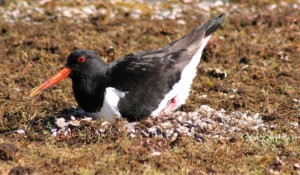 LINKED PAPER
LINKED PAPER
Vegetation structure influences predation rates of early nests in subarctic breeding waders. Laidlaw, R. A., Gunnarsson, T. G., Méndez, V., Carneiro, C., Þórisson, B., Wentworth, A., Gill, J.A. & Alves, J. A.. 2020. IBIS. DOI: 10.1111/ibi.12827 VIEW
A Raven (Corvus corax) glides across the barren landscape of Iceland. Looking down at the rocky terrain below, it meticulously scans each patch of vegetation and every irregular cluster of stones. Several shorebird species are nesting here and the Ravens eyes are focused on finding the slightest hint of a nest. Suddenly, it notices some movement in a small bush and swoops down. An adult Redshank (Tringa totanus) emerges from the vegetation, but the Raven is not impressed and quickly locates the nest. After devouring the eggs, it takes to the sky again, searching for the next nest to predate. This dramatic scene illustrates the stressful life of several wader species in Iceland. Some species, such as the Redshank in this story, hide their nests in dense vegetation, while other species build their nest on the bare ground (Smith et al. 2012, Troscianko et al. 2016). Which strategy has the better chance of survival?
Monitoring
In 2015-2016, a team of ornithologists monitored the nest survival of six wader species on the shores of Iceland. Three of these species conceal their nest in the scarce vegetation: Redshank, Black-tailed Godwit (Limosa limosa) and Snipe (Gallinago gallinago). The other three build open nests on the stony soil: Oystercatcher (Haematopus ostralegus), Golden Plover (Pluvialis apricaria) and Whimbrel (Gallinago gallinago). Statistical analyses revealed similar nest predation rates for both strategies, but nest-concealing species were more likely to be predated when their nests were poorly concealed. This mostly occurred in colder conditions or at the start of the breeding season when the vegetation has not grown dense yet. Hence, the alert Raven in the opening scene probably spotted a badly hidden Redshank nest.

Figure 1 Locations of the nesting sites in Iceland.
Climate change
These findings have important implications in the context of future climate change (Gunnarsson et al. 2017). With increasing temperatures, the now barren landscape of Iceland might become more densely vegetated (Thorvaldsson et al. 2005). This could provide the nesting waders with more and better opportunities to hide their nests. The high predation rates in this area (about 40% in this study) might drop dramatically, leading to significant population growth of some shorebirds. It is, however, also possible that the predators will consequently improve their ability to find nests, being rewarded with a plentiful food source (MacDonald & Bolton 2008). If we would asked the future Raven how many wader eggs it ate, it might reply – like the bird in Edgar Allen Poe’s “The Raven” – with “Never more”.
References
Gunnarsson, T.G., Jóhannesdóttir, L., Alves, J.A., Þórisson, B. & Gill, J.A. (2017). Effects of spring temperature and volcanic eruptions on wader productivity. Ibis 159: 467– 471. VIEW
MacDonald, M.A. & Bolton, M. (2008). Predation on wader nests in Europe. Ibis 150: 54– 73. VIEW
Smith, P.A., Tulp, I., Schekkerman, H., Gilchrist, H.G. & Forbes, M.R. (2012). Shorebird incubation behaviour and its influence on the risk of nest predation. Animal Behaviour 84: 835– 842. VIEW
Thorvaldsson, G., Björnsson, H. & Hermannsson, J. (2005). The influence of weather on early growth rate of grasses. Icelandic Agricultural Studies 4: 65– 73. VIEW
Troscianko, J., Wilson‐Aggarwal, J., Stevens, M. & Spottiswoode, C.N. (2016). Camouflage predicts survival in ground‐nesting birds. Scientific Reports 6: 19966. VIEW
Image credits
Top right: Oystercatcher Haematopus ostralegus | John Haslam | CC BY-SA 2.0 Wikimedia Commons
Blog posts express the views of the individual author(s) and not those of the BOU.
If you want to write about your research in #theBOUblog, then please see here





